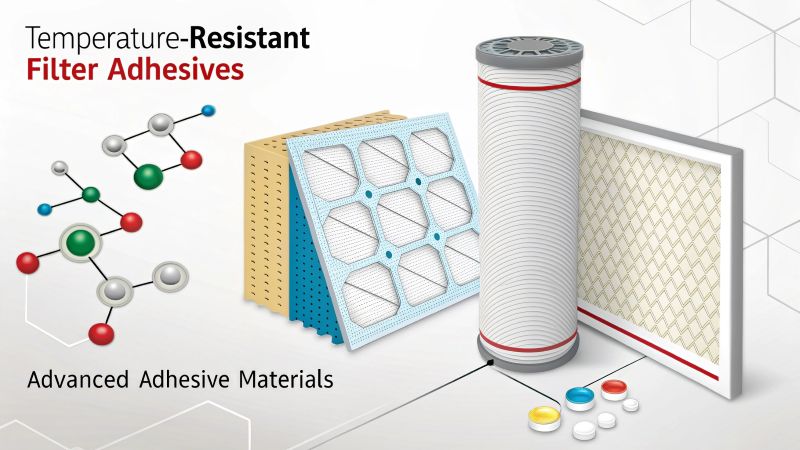
Understanding Filter Adhesives
Types of Innovative Adhesives
Importance of Adhesive Efficiency
Methods to Enhance Durability
Latest Trends in Adhesive Tech
Strategies for Improved Adhesion
Future of Filter Adhesives
Frequently Asked Questions (FAQ)
Filter adhesives are essential for maintaining the integrity and efficiency of filtration systems. These adhesives securely bond various filter components—such as end caps, media, and housings—allowing filters to endure high pressures, thermal variations, and operational wear. Advanced adhesive technologies now offer enhanced durability and flexibility, making them a crucial part of modern filter design across industries.
Several types of adhesives are widely used in filter manufacturing due to their unique properties:
Polyurethane adhesives: Known for their flexibility and resistance to environmental stress, ideal for dynamic filter systems.
Epoxy adhesives: Provide high bonding strength and chemical resistance, suitable for industrial environments.
Silicone adhesives: Offer excellent thermal stability, making them ideal for high-temperature applications.
Fast-curing multipurpose adhesives: Used when rapid assembly and versatile bonding are needed.
Choosing the right adhesive type ensures optimal filter performance, even under challenging conditions.
Adhesive efficiency is critical in ensuring that filter components remain securely bonded throughout their operational lifespan. High-efficiency adhesives reduce the risk of leakage, structural failure, and premature degradation. Modern filter adhesives are engineered to withstand environmental and mechanical stresses while also providing ease of application and consistent performance. By maximizing efficiency, manufacturers can extend filter service life and minimize maintenance costs.
Enhancing the durability of filter adhesives requires a combination of material selection and application strategy:
Formulation optimization: Selecting adhesives resistant to chemicals, vibration, and temperature fluctuations.
Accurate application: Using precision equipment to ensure consistent adhesive coverage.
Proper surface preparation: Cleaning and priming surfaces to maximize bond strength.
Controlled curing: Managing temperature and humidity during curing to avoid bond failure.
These methods contribute to the long-term reliability of filtration systems in demanding environments.
The adhesive technology landscape is rapidly evolving to meet growing demands in the filtration industry. Current trends include:
Eco-friendly formulations with lower VOC emissions and higher recyclability.
Hybrid adhesives that combine the flexibility of polyurethanes with the strength of epoxies.
Quick-set adhesives for streamlined manufacturing.
Smart bonding technologies responsive to temperature or wear indicators.
These innovations not only improve durability but also align with sustainability and process efficiency goals.
To ensure optimal adhesion in filter production, manufacturers can follow several strategic approaches:
Select the right adhesive chemistry for the materials and expected conditions.
Ensure clean and properly pretreated surfaces to prevent bond failure.
Use precision dispensing systems to control adhesive volume and application path.
Employ advanced formulations that maintain performance despite environmental and mechanical stress.
These practices help maximize bonding reliability and reduce defects in mass production.
The future of filter adhesives will be defined by higher performance, environmental safety, and digital integration. Research is advancing toward:
Bio-based and recyclable adhesives
Greater chemical resistance for use with complex media
Bonding solutions compatible with smart manufacturing systems
Adhesives suited for new filter designs in electric vehicles and clean energy sectors
As filtration demands increase across industries, adhesive solutions must evolve to offer greater adaptability and efficiency.
Q1. What are filter adhesives and why are they important?
Filter adhesives are materials used to bond parts of a filter together, ensuring mechanical strength and leak prevention under operating conditions.
Q2. What types of adhesives are used in filters?
Common types include polyurethane (for flexibility), epoxy (for strong chemical resistance), silicone (for heat stability), and fast-curing types for rapid production.
Q3. Why is adhesive efficiency important in filters?
Efficient adhesives maintain bond strength and prevent leakage, helping filters perform reliably over time.
Q4. How can I improve the durability of filter adhesives?
Use optimized formulations, ensure proper surface preparation, apply adhesive precisely, and follow recommended curing procedures.
Q5. What trends are shaping adhesive technology in filters?
Trends include eco-conscious formulations, quick-setting options, hybrid chemistries, and responsive smart adhesives.
Q6. How can I improve bonding in filter manufacturing?
Choose adhesives suitable for specific substrates and conditions, maintain clean surfaces, and standardize application procedures.
Q7. What’s next for filter adhesives?
The future involves smarter, stronger, and more sustainable adhesives that align with digital manufacturing and high-performance demands.
Q8. What should I consider when selecting a filter adhesive?
Consider mechanical requirements, temperature and chemical exposure, curing speed, environmental compliance, and long-term reliability.